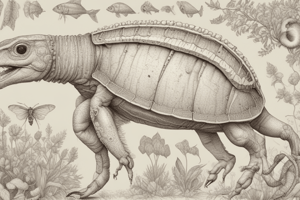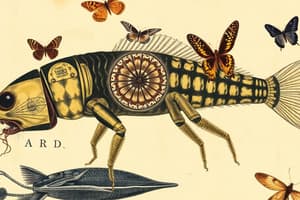Podcast
Questions and Answers
Which feature is NOT characteristic of the Phylum Echinodermata?
Which feature is NOT characteristic of the Phylum Echinodermata?
- Presence of an endoskeleton
- Radial body symmetry
- Hard exoskeleton (correct)
- Water vascular system
What type of feeders are Sea Cucumbers primarily categorized as?
What type of feeders are Sea Cucumbers primarily categorized as?
- Filter feeders
- Herbivores
- Carnivorous
- Detritus feeders (correct)
Which characteristic is unique to insects compared to centipedes and millipedes?
Which characteristic is unique to insects compared to centipedes and millipedes?
- Two pairs of legs per segment
- Long body consisting of many segments
- One pair of antennae
- Body divided into three parts (correct)
Which of the following echinoderms is characterized by a star-shaped body and is carnivorous?
Which of the following echinoderms is characterized by a star-shaped body and is carnivorous?
What is the primary feeding strategy of millipedes?
What is the primary feeding strategy of millipedes?
Which structure in sea stars is involved in their unique method of movement?
Which structure in sea stars is involved in their unique method of movement?
Which type of symbiotic relationship involves one organism being harmed?
Which type of symbiotic relationship involves one organism being harmed?
What type of symmetry do most echinoderms exhibit?
What type of symmetry do most echinoderms exhibit?
What structure in grasshoppers plays a similar role to kidneys in other organisms?
What structure in grasshoppers plays a similar role to kidneys in other organisms?
What is the primary characteristic of the sea urchin's body structure?
What is the primary characteristic of the sea urchin's body structure?
How do insects primarily obtain oxygen?
How do insects primarily obtain oxygen?
Which type of skeleton is not typically found in invertebrates?
Which type of skeleton is not typically found in invertebrates?
Which of the following is NOT a characteristic of uniramians?
Which of the following is NOT a characteristic of uniramians?
Which of the following groups are filter feeders among echinoderms?
Which of the following groups are filter feeders among echinoderms?
What type of metamorphosis do butterflies undergo?
What type of metamorphosis do butterflies undergo?
Which of the following arthropods primarily lives in aquatic environments?
Which of the following arthropods primarily lives in aquatic environments?
Which of the following phyla is characterized by organisms that are primarily asymmetrical?
Which of the following phyla is characterized by organisms that are primarily asymmetrical?
What is the correct order of body cavity evolution?
What is the correct order of body cavity evolution?
In protostomes, what does the blastopore develop into?
In protostomes, what does the blastopore develop into?
Which body symmetry is described as having only one plane of symmetry?
Which body symmetry is described as having only one plane of symmetry?
What is the main characteristic of animals classified under Phylum Nematoda?
What is the main characteristic of animals classified under Phylum Nematoda?
What is cephalization in the context of animal evolution?
What is cephalization in the context of animal evolution?
Which of the following describes organisms with radial symmetry?
Which of the following describes organisms with radial symmetry?
Which germ layer is responsible for forming the outer layer of cells in an animal?
Which germ layer is responsible for forming the outer layer of cells in an animal?
Flashcards
Uniramians
Uniramians
A subphylum of arthropods characterized by a single pair of antennae, mandibles, and a body divided into segments. Most uniramians are terrestrial.
Centipedes
Centipedes
Terrestrial arthropods with a long segmented body, one pair of legs per segment, and venomous claws for hunting.
Millipedes
Millipedes
Terrestrial arthropods with a long segmented body, two pairs of legs per segment, and mostly herbivorous diet.
Insects
Insects
Signup and view all the flashcards
Insect Metamorphosis
Insect Metamorphosis
Signup and view all the flashcards
Mutualism
Mutualism
Signup and view all the flashcards
Commensalism
Commensalism
Signup and view all the flashcards
Parasitism
Parasitism
Signup and view all the flashcards
What are the characteristics of animals?
What are the characteristics of animals?
Signup and view all the flashcards
List all the invertebrate phyla.
List all the invertebrate phyla.
Signup and view all the flashcards
What are the important trends in animal evolution?
What are the important trends in animal evolution?
Signup and view all the flashcards
What is cell specialization?
What is cell specialization?
Signup and view all the flashcards
What is the difference between protostomes and deuterostomes?
What is the difference between protostomes and deuterostomes?
Signup and view all the flashcards
What are the different types of body symmetry in animals?
What are the different types of body symmetry in animals?
Signup and view all the flashcards
What is cephalization and how is it beneficial?
What is cephalization and how is it beneficial?
Signup and view all the flashcards
What is a coelom and its significance?
What is a coelom and its significance?
Signup and view all the flashcards
Phylum Echinodermata
Phylum Echinodermata
Signup and view all the flashcards
Water Vascular System
Water Vascular System
Signup and view all the flashcards
Sea Stars
Sea Stars
Signup and view all the flashcards
Brittle Stars
Brittle Stars
Signup and view all the flashcards
Sea Urchins
Sea Urchins
Signup and view all the flashcards
Sea Cucumbers
Sea Cucumbers
Signup and view all the flashcards
Exoskeleton
Exoskeleton
Signup and view all the flashcards
Endoskeleton
Endoskeleton
Signup and view all the flashcards
Study Notes
Invertebrate Characteristics
- Animals without a backbone are invertebrates.
- Invertebrates comprise a large group within the Kingdom Animalia.
- They exhibit diverse body plans and adaptations.
Invertebrate Phyla
- There are eight major phyla.
- These phyla include Porifera, Cnidaria, Platyhelminthes, Nematoda, Annelida, Mollusca, Arthropoda, and Echinodermata.
- Each phylum has unique characteristics.
Trends in Animal Evolution
- Cell Specialization: Different cell types originate from three embryonic germ layers (ectoderm, mesoderm, and endoderm).
- Early Development: Protostomes develop the mouth first, and deuterostomes develop the anus first.
- Body Symmetry: Types include asymmetry, radial symmetry, and bilateral symmetry.
- Cephalization: Sensory organs and nerve clusters concentrating at the anterior (head) end.
- Body Cavity: Three stages in coelom development exist: acoelomate (no body cavity), pseudocoelomate (partially lined body cavity), and coelomate (fully lined body cavity).
Animal Phylum Examples
- Porifera (sponges): Lack true tissues and organs; filter feeders with a porous body.
- Cnidaria (cnidarians): Radial symmetry; carnivorous; have stinging cells called nematocysts. Include classes like Hydrozoa, Scyphozoa, and Anthozoa.
- Platyhelminthes (flatworms): Unsegmented; acoelomate; free-living or parasitic. Includes classes Turbellaria, Trematoda, and Cestoda
- Nematoda (roundworms): Unsegmented; pseudocoelomate; have a complete digestive system with a mouth and an anus. Includes parasitic and free-living forms.
- Annelida (segmented worms): Segmented bodies; coelomate; have a closed circulatory system. Examples include Polychaetes (bristle worms), Oligochaetes (earthworms), and Hirudinea (leeches).
- Mollusca (mollusks): Soft-bodied; have a muscular foot, a mantle, and a visceral mass. Examples include Bivalvia (clams, oysters), Gastropoda (snails, slugs), and Cephalopoda (octopus, squid).
- Arthropoda (arthropods): Segmented bodies; exoskeleton made of chitin; jointed appendages. Includes subphyla like Trilobita (extinct), Chelicerata (spiders, scorpions), Uniramia (millipedes, centipedes, insects), and Crustacea (crabs, lobsters, shrimps).
- Echinodermata (echinoderms): Radial symmetry; endoskeleton; water vascular system. Examples include sea stars, sea urchins, sea cucumbers.
Invertebrate Systems
- Skeletal systems: Exoskeletons, endoskeletons, hydrostatic skeletons.
- Digestive systems: One-opening digestive systems in some, two-opening digestive systems in others
- Circulatory systems: Open circulatory systems and closed circulatory systems.
- Respiratory systems: Diffusion across skin, gills, book lungs, tracheal tubes.
- Excretory systems: Flame cells, nephridia, Malpighian tubules.
- Nervous systems: Simple nerve nets, centralized nerve cords.
Studying That Suits You
Use AI to generate personalized quizzes and flashcards to suit your learning preferences.




